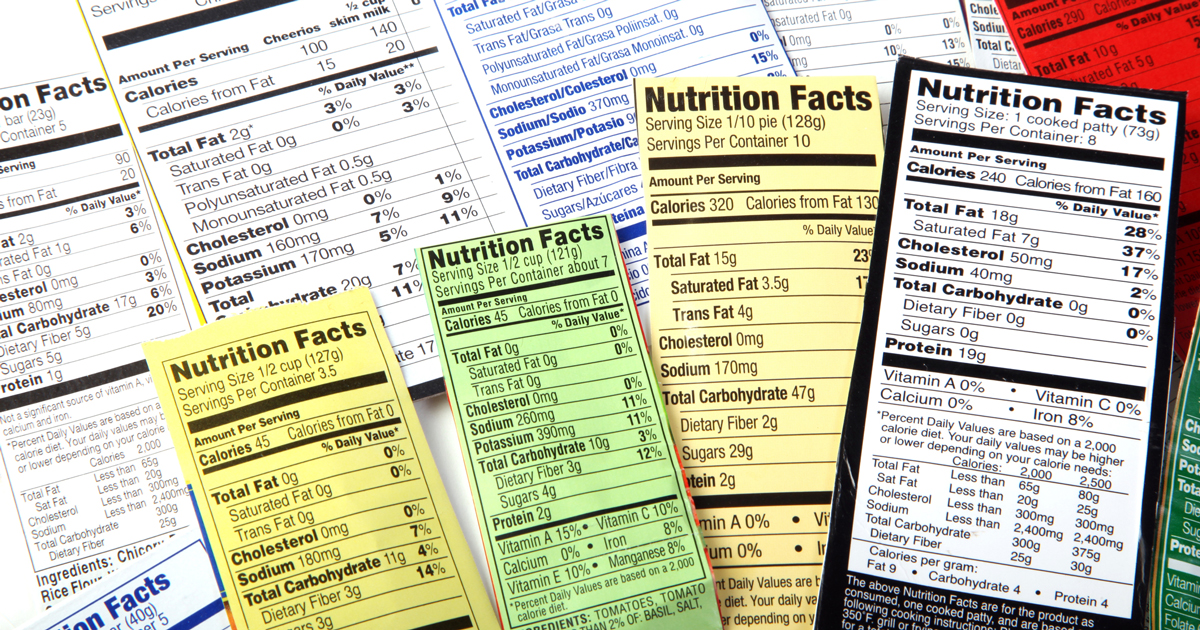How nutrition labels work: 7 tips for demystifying foods

Nutrition labels give us detailed information on the foods that we put into our bodies. If you're not sure where to look, food labels can be overwhelming because of all the bits of information they contain.
What you look at most depends on your goals. For example, if you want to lose weight, you'll focus on different parts of the label compared to bodybuilders or a person with diabetes.
In this post, I'll show you what to look for depending on your goals. There are calories, fats, vitamins, ingredients and more.
Serving size versus portion size
The serving size is the specific amount listed on the label. Your portion size is how much you're actually eating. They don't always match.
Let's say you get a package of M&Ms. Technically, it says “Number of servings: 2” on the label. But typically you'd just eat the whole thing because it seems like a normal snack size.
So your portion size was the whole package, but a serving is half of the package. That means you have to double everything listed on the label.
Here's another example with cereal. Some breakfast cereals list one serving size as a fourth of a cup. But we don't usually measure cereal – we throw it in a bowl with some milk and dig in. So the first thing to do is get your measuring cups out. Measure how much cereal you put in the bowl and then do some simple math. If you plan to eat a full cup of cereal, that's equal to four servings. That means you should multiply everything on the nutrition label – calories, sugar, vitamins and so on – by four.
1. Use the right numbers: Multiply serving size (what's listed on the label) to get to your portion size (what you actually ate).
Macronutrients
Calories come in three different macronutrients: fats, carbohydrates and proteins.
Carbohydrates include fiber and sugar. Adding more fiber to your diet is a great idea, especially since it can help regulate your digestion. As for sugars, there's a difference between added sugars (like high fructose corn syrup) and natural sugars, like the sugars you'd find in a piece of fruit. Avoid added sugars when possible.
Fats include unsaturated fats, saturated fats and trans fats. You want zero trans fats. Unsaturated fats, which can be found in nuts, oils and seeds, are considered healthier fats. Try to limit saturated fats, which typically come from animal products.
Proteins include animal sources (meat, fish, dairy and eggs) and nonanimal sources (soy, nuts, seeds and legumes). Lean meats are typically better for you than processed or high fat, but it depends on your dietary goals.
2. Increase fiber. Heavily processed foods usually remove fiber. Increasing your fiber intake is typically a good thing.
3. Limit added sugars. The lower the number of added sugars, the better. Sugar can come in many sneaky names. Watch out for: sucrose, fructose, high-fructose corn syrup, barley malt, dextrose, maltose and more.
4. Avoid trans fats. Your body has a hard time using trans fats, so avoid them as much as possible.
Daily value percentages
This is the percent of a nutrient based on a 2,000 calories per day diet.
So let's say your label says there are eight grams of fat, per serving. Next to that, it says 10% of your fat intake. What that means is: if you eat 2,000 calories each day, one serving size of the product you're looking at contains 10% of all the fat you should consume for that whole day.
In practice, few people eat exactly 2,000 calories per day, and everyone has their own goals. So you can use the daily value percentages to see if the food has a little or a lot of a nutrient and compare the nutritional value of different foods.
Let's say the percentage listed next to fat is 50%. That means you're getting half of the amount of fat that you should get in your day from this one food. If your goal is to lose weight, you probably want to avoid that food.
5. Decrease fats, sugar and salt: If it's something you're trying to limit – like fat, salt or sugar – you want to choose foods with a lower daily value percentage. A good benchmark is 20% or lower.
6. Increase vitamins and minerals: If it's healthy for you – like a vitamin or mineral – it's great if the percentage is high.
Focus on your goals
If you're in the grocery store, try to pick between two or three products at a time. One tip is to compare. You're never going to find a label with a perfect breakdown of everything because the perfect food doesn't exist.
If your goal is weight loss, check out the calories in two different products. They may have similar numbers for calories, but one is much lower in fat. So choose that one. Or maybe the fat percentages are about the same, but you notice that one product has way more added sugars – avoid that one.
If your goal is bodybuilding, you'll probably compare amounts of proteins and fats. And if you have diabetes or are watching your blood sugar, you can zone in on added sugars and carbohydrates.
7. Compare just one or two things at a time: Use your goal to decide what to focus on: calories, fats, added sugars, fiber, protein or something else?
Our meal replacement program takes the guesswork out of weight loss. Call 402.559.9500 to get help from a friendly team of doctors and dietitians.







